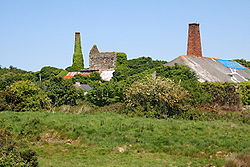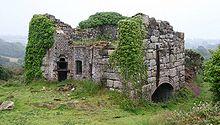- Wheal Busy
-
Wheal Busy 
Old mine buildings at Wheal BusyLocation Location in Cornwall 50.258°N 5.174°W / 50.258°N 5.174°WCoordinates: 50.258°N 5.174°W / 50.258°N 5.174°W
Location Chacewater County Cornwall Country England Production Products Mainly copper, tin and arsenic History Opened 16th century Closed 1920s Wheal Busy, sometimes called Great Wheal Busy and in its early years known as Chacewater Mine, was a metalliferous mine half way between Redruth and Truro in the Gwennap mining area of Cornwall, England. During the 18th century the mine produced enormous amounts of copper ore and was very wealthy, but from the later 19th century onwards was not profitable. Today the site of the mine is part of the Cornwall and West Devon Mining Landscape World Heritage Site.
Contents
Geology
The country rock at the mine was killas and the mine's main produce was copper, though arsenic and tin were also produced. There are several lodes at the mine, some of which were crossed by an elvan dyke, 15 to 40 ft (12 m) wide which in places was highly mineralized.[1]
Early history
There were probably mine workings in the area of Wheal Busy since the 16th century, but it was not until the 1720s that the mine started to produce large amounts of copper ore. The mine was located in what was known at the time as "the richest square mile on Earth". During its life it produced over 100,000 tons of copper ore, and 27,000 tons of arsenic.[2]
The mine suffered badly from underground water and in order to pump it out, one of the first Newcomen engines in Cornwall was installed by Joseph Hornblower in 1727.[3] In 1775 this was replaced by a 72 inch engine designed by John Smeaton which was not very effective and was rebuilt by James Watt in 1778, making it one of the first Watt steam engines in the county.[4] Also in 1778, the mine benefited from being connected to the Great County Adit, which also helped drainage.[2]
1850 onwards
To celebrate a restarting of the mine in 1856, a "gargantuan feast" was held in the village of Chacewater. Watched by crowds, a thousand people marched through the village to the mine where the cornerstone for a large new engine house was laid. There was an excursion train on the West Cornwall Railway, a church service, a dinner was provided for 400 poor people, and at night there was a firework display. The feast itself took place in the marketplace and involved the roasting of a whole ox. Although large quantities of copper and tin ore were produced in the following ten years, no overall profit was made and the adventurers lost more than £150,000 in the mine.[5]
In 1866 there was a wave of sabotage by some of the miners against the adventurers when in an attempt to reduce the mounting losses, a new mine captain imposed what amounted to a tax on their earnings. According to newspaper reports at the time the miners set about "attempting to blow up the boilers, laying trails of [gun]powder about the barracks, setting fire to the clothes in the dry, throwing large pieces of iron in the pumps, and other villainous acts." The mine closed down shortly afterwards.[6]
In the 1850s the water drawn from the mine was being used for the steam engines, but it was so corrosive that each year six of the twenty four boilers had to be renewed. It was not until 1862 that a supply of clean water was arranged to solve this problem.[7] The last significant production of copper ore from the mine was in 1866 (1,630 tons), though it sold small amounts (less than 100 tons) in each of the following three years.[8] In 1873, in the middle of the slump in copper prices, the mine was reopened and a new 90 inch pumping engine was purchased from Perran Foundry, despite there being many second-hand engines cheaply available at the time. Only seven months after it started work the engine was up for sale and the mine had closed without producing any ore at all.[9]
In around 1910 the mine installed a second-hand 85 inch pumping engine,[2] and to help with its production of arsenic, a Brunton calciner was built.[10] In the 1920s a set of Californian stamps was installed to rework the waste dumps for ore.[2] During the Second World War, 2,500 American GIs were billeted on the site and were said to have restarted the 85 inch pumping engine.[10]
Today, the site is within area A6i (The Gwennap-Chacewater Mining District)[11][12] of the Cornwall and West Devon Mining Landscape World Heritage Site. There are good remains of the Brunton calciner,[10] and the concrete bases of the Californian stamps are prominent. The Mineral Tramways cycle path passes the mine.
References
- ^ Dines 1956, p.389
- ^ a b c d "Wheal Busy (Chacewater Mine)". Cornwall in Focus. http://www.cornwallinfocus.co.uk/history/whealbusy.php. Retrieved 2009-08-01.
- ^ Barton 1966, p.16
- ^ Barton 1966, pp.20–22
- ^ Barton 1968, pp.44–45
- ^ Barton 1968, p.47
- ^ Barton 1966, p.116
- ^ Burt et al. 1987, p.66
- ^ Barton 1966, p.71
- ^ a b c Hancock 2008, p.64
- ^ "The Gwennap-Chacewater Mining District". Cornwall Council. http://www.cornish-mining.org.uk/sites/gwennap.htm. Retrieved 2009-08-01.
- ^ "Cornish Mining World Heritage - Gwennap Mining District Location Map". Cornwall Council. http://www.cornish-mining.org.uk/sites/gwennaplocationmap.htm. Retrieved 2009-08-01.
Sources
- Barton, D. B. (1966). The Cornish Beam Engine (New ed.). Truro: D. Bradford Barton Ltd.
- Barton, D. B. (1968). Essays in Cornish Mining History, Volume 1. Truro: D. Bradford Barton.
- Burt, Roger; Waite, Peter; Burnley, Ray (1987). Cornish Mines: Metalliferous and Associated Minerals 1845–1913. University of Exeter. ISBN 0-85989-287-5.
- Dines, H. G. (1956). The Metalliferous Mining Region of South-West England. Volume I. London: HMSO. pp. 389–391.
- Hancock, Peter (2008). The Mining Heritage of Cornwall and West Devon. Wellington, Somerset: Halsgrove. ISBN 978 1 84114 753 6.
Categories:- Tin mines in Cornwall
- Copper mines in Cornwall
Wikimedia Foundation. 2010.


